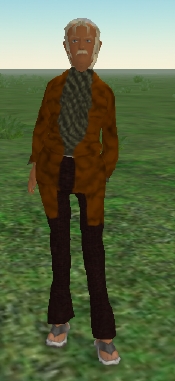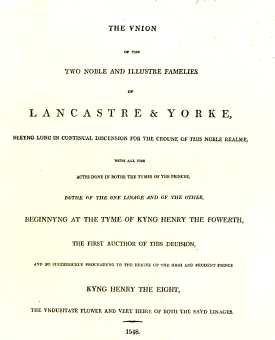
Life on the Internet
May 22, 2007
Henry VIII spent money. A lot of it. In the course of his forty-year reign he emptied a very full royal treasury. Although he refilled it by means of a couple of heavy rounds of taxation, and, notoriously, by expropriating the wealth and property of every monastery in the land, he still managed to leave it close to empty by the time he died.
Much of the money was spent waging war, usually with France, but a huge amount also went on royal magnificence: richly decorated palaces, jewel-bedecked robes of state, and the most extravagantly opulent parties and celebrations anyone had ever seen. Henry loved to put on a party – especially in the first years of his reign. Such occasions would include one or more banquets (for hundreds of guests), pageants, games, dancing, and almost always a joust and a martial arts tournament.
A contemporary chronicler exclaimed,
If I should declare what pain, labour, and diligence, the tailors, embroiderers and goldsmiths took, both to make and devise garments for Lords, Ladies, Knights and Esquires, and also for bedecking, trapping, and adorning of Coursers, lenetts, and Palfreys, it were too long to rehearse; but for a surety, more rich, nor more strange nor more curious works, have not been seen, than were prepared for this [occasion].1
I quote this passage for two reasons:
1. Anyone who studies the history of England in the 16th Century is certain to come across references to the book in which the passage is found: Edward Hall’s The Union of the two Illustrious and Noble Families of Lancaster and York, being long in continual dissention for the crown of this noble realm...&c (usually referred to as “Hall’s Chronicle”), which was first published in 1548. Scholars may make assertions such as: “Hall says, but he is mistaken,” or, “Hall’s account of this event is confirmed by...,” but again and again it is to Hall that historians and students turn for an account of events in that tumultuous age. Literature students, too, must deal with Hall, because his Chronicle was a key sourcebook for most of Shakespeare’s history plays.
I have known of Hall all my adult life, but I have never actually seen or looked into a copy of his work. You can imagine, therefore, my delight to find a complete edition of it on the Internet! It seems that, in recent years, university libraries have been diligently scanning extant copies of such works, and putting them on the web. I came across Hall’s Chronicle in early April, and have been studying it intensely ever since. It is a mighty tome – over 900 pages of close-packed print, but I love contemporary sources, and Hall is one of the best.
2. Hall lovingly describes the fine costumes, the floats, the feasts and the displays, and sometimes he comments, almost as an aside, about how the craftspeople had to stay up all night finishing the clothing or the decorations for the next day’s celebration. This got me thinking: about wealth and poverty, magnificence and hunger. Henry was genuinely admired by his subjects. In many ways they approved of his extravagant display, even though an individual item, worn only once, might cost the equivalent of a couple of years’ normal salary. Paradoxically, those carpenters and embroiderers, who worked all night on the next day’s display, considered themselves privileged to do so.
A comparison can probably be made to American Idol, or to the Academy Awards. Although the celebrities involved are entertainers rather than royalty, these events are costly and transitory just like King Henry’s extravaganzas, but to millions of people, who could never afford such display except in their dreams, they are something to celebrate, take pride in, and enjoy; and the stage hands, carpenters, and seamstresses who work on these events see themselves as celebrities too.
Recently I have been turning more and more to the Internet as I continue to do background research for my own writing project. There are some superb resources on the web, not least of which are primary documents such as this Chronicle.
Needless to say I’ve been doing more research than writing. The time has long since come when I should put down Mr. Hall and get back to the deathless prose of my own slowly developing book. But then, when I do write for a little bit, sooner or later I come to a point where some fact or other needs to be checked, and... back to research I go. Have you any idea of the number of monks and nuns there were in England at the height of the middle ages? Although a reliable answer is bound to be out there somewhere, it is not very easy to find! But I do enjoy the hunt.
Second Life
I enjoy the Internet for its own sake, too, not only for the research. I like the inter-connectedness of it, and the sense it gives of infinite possibilities. Also, learning the technical skills required for creating simple web pages always presents an interesting challenge. I work on my own website (this one) when I can, and currently I spend every Thursday afternoon editing and expanding the website of the parish of St. Luke (in fact, there are weeks when I work on the parish website many more days than just Thursday)!Now it is not exactly unheard-of that a person who enjoys the Internet can also, if I may be candid here, waste a lot of time on it. And, I confess that I myself might have such a tendency.
It was in the context of doing St. Luke’s web page that I came across a real Internet time-waster! I was asking some members of the parish to go online and critique what I was doing when one of them said, by way of making conversation, “Have you tried Second Life yet?“
Well, I had not, but from the description he gave, I thought it might be fun to check out.
Second Life is supposed to be a parallel world in which you create a character, who then goes about in a virtual environment earning money, spending it, having relationships, and doing projects. It’s just like real life, in a sense, except that you can choose who you want to be, and can also control some of the things which usually cannot be controlled from day to day. I suspect that the appeal of virtual reality is something akin to that of theatrical improv: you have to make up the responses of your character and create your storyline on the fly. I have often enjoyed watching my sons engaging in this sort of thing – very creatively indeed – but my only reservation about their preferred venue2 was that its central point is the killing of computer-generated monsters, something which has very little appeal for me. Thus, when I learned about Second Life, I thought here might be an interesting virtual life pastime, without the combat, but with all the other fun stuff.

My character in Second Life
Well, the project was a dismal failure. In the imaginary world I wandered through all kinds of places where there were lovely, expensive-looking homes and shopping malls, but nobody much around. Moreover, when I did find people – well, virtual people – they certainly weren’t interested in scruffy old codgers. Often, when my character entered a room, one by one the others present would slowly get up and drift away!
And then there was the deliberately bad stuff: for example, I came across a sofa in a very pleasant virtual outdoor environment, directly across from a virtual church, and it looked as if it would be nice to sit on, to wait and see if anyone would come along. Well, it turned out that the sofa was booby-trapped. As soon as I sat down on it, my virtual self was transformed into a kind of tree-person, with leafy limbs and a bark-covered body. I couldn’t change back for love or money! In the end I had to quit the program, and re-start it. Then I looked “normal” once more.
On another occasion, I had found a meeting place where people from all over the world tend to congregate (most of them virtually beautiful and expensively dressed!). I was sitting there (others giving me a wide berth, as usual) when a new virtual individual entered, concocted to appear naked from the waist down. Um, definitely a male. Then the creature tried to rub its enormous virtual erection up against the virtual ladies in the place. Charming.
Later in the same place another scene-wrecking event happened when one or more people operating virtual creatures tried to smash and wreck everything where others were visiting and chatting. Naturally due to the nature of the software, nothing was even virtually wrecked, but a large black object with huge wings rolled about making a screaming noise, then a fire appeared, and a virtual explosion. Clearly these were hostile, anti-social acts, even though nothing could actually happen.
So... Second Life turned out to be much like real life: old “uncool” people are ignored or avoided; there is considerable materialism, but precious little thought; and human sinfulness finds a way to wreak havoc upon what is intended to be an innocent pastime. It didn’t help, either, that the graphics loaded slowly, and my system often crashed.
I probably won’t return.
Besides, I found something much, much, better.
Dawn, who lives in Nova Scotia, decided to see if she could locate other members of her family in Facebook and typed “Harwood-Jones” into the search box. She wasn’t really surprised to find the names of my two daughters appearing on her screen, but she wasn’t quite ready for the ten or fifteen other Harwood-Jones names that also appeared.
Harwood-Jones is a unique surname, formed in England in the late 19th Century, and arriving to Canada in 1909 in the person of one man, Henry Harwood-Jones, and his wife, Jenny – my grandparents. If you meet anyone with that surname in Canada, odds are they’re descended from that couple. They are my relatives.
Facebook originated as a school and university network, so the vast majority of its inhabitants are young. The people whose names appeared in my sister’s search are our relatives, alright, but are they are actually the fourth and fifth generation descended from our grandparents!
Needless to say, there was a flurry of exchanges, asking “Who are you?” on both sides, and not long afterwards Dawn contacted me to say “You’ve got to see this! Get on Facebook right away!” I did, and Rachael typed, “Aunt Dawn! You managed to get my dad on Facebook! Congratulations! He wouldn’t do it for me!”
Well, earlier, when Rachael told me she had joined, I couldn’t see the point of belonging to an online network for myself, but now the thought of connecting with a family that I didn’t realize I had was very intriguing! It is probably something to do with old age, but I am not the first, and certainly won’t be the last senior citizen to become involved in remembrances, roots, and family origins. So, I did it; I joined Facebook and began to meet the descendents of my scarce-remembered cousins.
Meanwhile, these youngsters began to work on their own parents and grandparents to join the fun, and soon there was a thriving little network of relations typing to each other and trading opinions and photographs! For a while I became so busy making their acquaintance that I posted, for their amusement, the picture you see here. Note the fast-typing hands!

Tony, active on Facebook
I began to construct a family tree based on what I was learning from them, and to this point I have identified one hundred and five persons 3 who are direct descendents of my grandparents. Some have died, of course (my parents’ generation, for example, and increasingly my own generation), and some of them are infants – but more than forty are now active in Facebook, and through them I have had email contact with even more. As I developed it, I put my family tree online, here, and my new-found relatives have been clicking madly on it – either to correct me with names or spelling, or to see what I had learned that they themselves did not know!
So many of us are having so much fun that now there is talk of an actual family reunion 4. If not a reunion, then on one of my visits to Toronto (where a large number of them live) I suspect there will be a boisterous gathering of quite a few Harwood-Joneses in someone’s back yard. Can you imagine a bunch of people uncannily like me all in one place? Naturally, I’m looking forward to it.
FOOTNOTES:
1 Hall’s Chronicle, 1809 edition, page 507. I have modernized the spelling.
Click here to get back to the narrative.
2 Chris and Troy enjoy playing World of Warcraft, an “M-MOG”, or “Massively Multiplayer Online Game”.
Click here to get back to the narrative.
3 By April, 2013, I had identified and entered 203 descendents of my grandparents into the Harwood-Jones family tree.
Click here to get back to the narrative.
4 That reunion actually came into being. In July 2008 over 100 descendents of Henry and Jenny Harwood-Jones came together in Ajax, Ontario. See the entry for July 5, 2008.

